Replaces
1997 Plymouth Grand Voyager Front Ceramic Brake Pads TRQ BFA73277
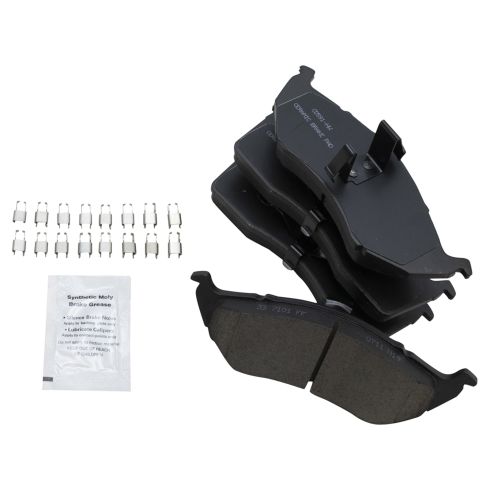

BFA73277
In Stock
This part doesn’t fit a . Select from parts that fit.
Specify your vehicle's year, make and model to guarantee fit.
Orders must be placed by 2pm ET
Get the kit
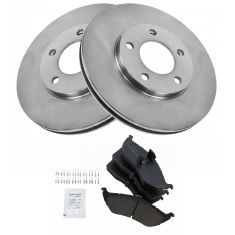
Ceramic Brake Pad & Rotor Kit
$103.95
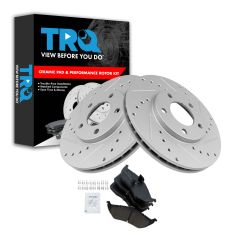
Ceramic Performance Brake Pad & Rotor Kit
$108.95
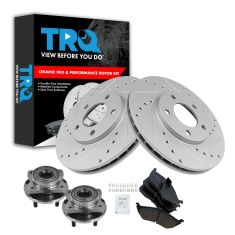
Ceramic Performance Brake Pad & Rotor Kit
$171.95
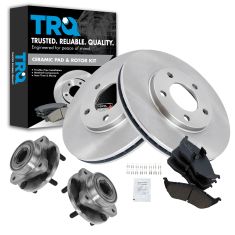
Ceramic Brake Pad & Rotor Kit with Wheel Bearings
$182.95
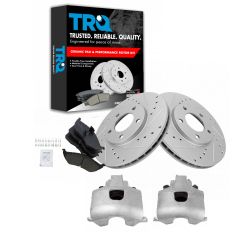
Ceramic Performance Brake Pad & Rotor Kit
$185.95
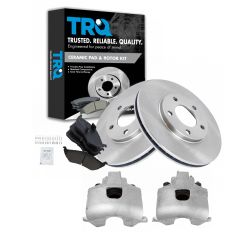
Ceramic Brake Pad & Rotor Kit with Calipers
$186.95
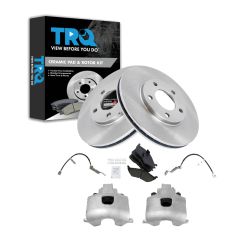
Ceramic 7 Piece Brake Pad & Rotor Kit with Calipers & Hoses
$201.95
Part Details
- Brake Pad Bonding Type: Premium Posi
-
Includes:
Contact Point Grease
Hardware - Brake Pad Friction Material: Ceramic
Specification
- Front
Product Features
TRQ brake pads are manufactured using premium raw materials and design standards to restore original performance. TRQ brake pads are positive molded and utilize a multi-layer shim for enhanced performance and service life. TRQ’s combination of materials and design ensures a low dust and low noise braking experience. TRQ recommends replacing your brake rotors when you replace your brake pads to ensure even wear of components and improved braking comfort. All products are fit and road-tested in our Massachusetts R&D facility to ensure we deliver on our promise of Trusted Reliable Quality.
Item Condition:
New
Attention California Customers:
![]() WARNING: This product can expose you to chemicals including Lead and Lead Compounds, which are known to the State of California to cause cancer, and birth defects or other reproductive harm. For more information, go to www.P65Warnings.ca.gov.
WARNING: This product can expose you to chemicals including Lead and Lead Compounds, which are known to the State of California to cause cancer, and birth defects or other reproductive harm. For more information, go to www.P65Warnings.ca.gov.
Lifetime Warranty
This item is backed by our limited lifetime warranty. In the event that this item should fail due to manufacturing defects during intended use, we will replace the part free of charge. This warranty covers the cost of the part only.
FREE Shipping is standard on Orders shipped to the lower 48 States (Contiguous United States). Standard shipping charges apply to Hawaii, Alaska and US Territories. Shipping is not available to Canada.
Expedited is available on checkout to the United States, excluding Alaska, Hawaii and US Territories as well as P.O. Boxes and APO/FPO/DPO addresses. Final shipping costs are available at checkout.



Created on:
Tools used
- Loosen the lug nuts with the vehicle on the ground Raise the vehicle with a floor jack Secure the vehicle on jack stands Remove the lug nuts Pull off the wheel
- Check the thickness of the brake pads Check the brake pad wear indicator Check for gouges on both sides of the rotor
- Remove the two 10mm bolts from the brake caliper Pull the caliper aside Pry the brake pads off with a flat blade screwdriver
- Pull the rotor off by hand
- Slide the rotor on Thread one lug nut to hold the rotor in place
- Pry the piston back with a flat blade screwdriver or push the piston in with a C-Clamp Put an old pad in the caliper Use a large C-clamp and the old pad to push the pistons back Install the new brake pads into the bracket Put the caliper on Thread the two 10mm bolts by hand Tighten the bolts to 20 foot-pounds
- Remove the placeholder lug nut Slide the wheel into place Start the lug nuts by hand Tighten the lug nuts preliminarily Lower the vehicle to the ground Tighten the lug nuts to 100 foot-pounds in a crossing or star pattern
- Pump your brakes repeatedly until they feel firm Test your brakes at 5 miles per hour and then 10 miles per hour Road test the vehicle
Brought to you by 1AAuto.com, your source for quality replacement parts and the best service on the Internet.
Hi, I'm Mike Green. I'm one of the owners of 1A Auto. I want to help you save time and money repairing or maintaining your vehicle. I'm going to use my 20-plus years experience restoring and repairing cars and trucks like this to show you the correct way to install parts from 1AAuto.com. The right parts installed correctly: that's going to save you time and money. Thank you and enjoy the video.
In this video, we're going to show you front brake repair on this 1997 Dodge Intrepid, same as any '93 to '97. This vehicle actually doesn't need new brakes so you won't see me put new brakes on it. You'll just see me take them off and put them on. Tools you'll need are jack and jack stands, either your tire iron or 19mm socket with a ratchet, possibly a breaker bar and a piece of pipe, and then you'll also need a 10mm socket and ratchet and a screwdriver.
First, you want to remove your wheel while the vehicle is on the ground. These lug nuts were on way too tight and what I had to do is I used a socket. Make sure your socket is on there good because these caps can kind of get bent and chewed up and make it more difficult. Make sure your socket is on there good. I used a breaker bar and a piece of pipe for extra leverage and I actually had to do that and loosen up all five lug nuts. Said another way, if you're using hand tools loosen the lug nuts on the ground, jack and support with jack stands the car so it's up in the air and then remove the lug nuts the rest of the way. Now we can check our condition.
You can see right here, there's a little slot that you can see. That's actually the brake pad. You can see the brake rotor here. It appears this car has pretty new brakes on it so I'm actually not going to change them. I'm just going to take it apart and put it back together. You can see here too, the pad and you can see there's a little bevel to it so there's space between the pad and the rotor there. That means that pad has plenty of wear left on it. For the rotors themselves, you take the back of your fingernail just run it up and down and you should feel a little texture but you shouldn't feel any deep grooves or gauges or anything. Like I said, these brakes look like they're still brand new, not brand new, but they're in very good shape so I'll just show you how to take them apart and put them back together.
Basically, what you're going to do is just remove two 10mm bolts: one here and one down here. Fast forward here, we use a 10mm socket with a ratchet handle and these bolts should come apart pretty easy. They're only supposed to be tightened in there at about 17 to 19 foot pounds. They just hold the caliper in place. They don't really absorb any of the braking pressure.
Use a screwdriver. It doesn't have to be huge. It just kind of helps you get things started. The caliper comes off and then the pads come right out of the caliper. Use a screwdriver and pry these clips right off, and push the pad. Again, as I said, this is the outer pad. That's a wear indicator, with plenty of life left there. The inner pad pulls right out, again, and that one has plenty of life left. I'm just doing this to show you.
Here, I just want to make sure you don't put any stress on your hose and then easily enough, the rotors come right off.
Put them back on. When I put it back together, I always like to stick a lug nut. It just holds things in place. If your brakes are worn, this piston will have worked its way out further on the caliper and you'll want to push it back in. Now you can do that a couple of ways. When it's still mounted, you can actually take a large screwdriver, larger than the one I have here but I'm just showing you with this one. You take a large screwdriver, you can put it in and then pry against either the rotor or one of the pads and that will work that piston back in and again, you'll want to use a large screwdriver for that.
The other possibility is using a large C-clamp. Have your little brake pad still installed in the caliper and take the C-clamp and you'll probably be able to see it a little bit. Just watch this piston here as I tighten up the clamp and it goes back into the caliper. Now, remove your clamp. My inside pad is already in there. It just pushes into the caliper. Let's put my outside one in correctly and all you do with this one is get it into place, and push it right in.
Now you're ready to put this back in. You want to make sure you push these bolts, these little slides, make sure they are nice and free. They should slide back and forth nice and easily. Push them out, and put your caliper in place. You might need to grab onto them and pull them. Grab onto this bottom one and just pull it out, pushing that on. With these little teeth or brackets, the top of your brake pads should be nice and tight against this caliper bracket.
Start our 10mm bolts back in. Just move it around a little bit until they find their way in. Tighten these 10mm bolts to 20 foot-pounds and you might say, "Well that's not all that tight for brakes". Again, these bolts just hold everything into place. This big bracket here is what really takes the braking pressure.
Apologies here, I forgot to change the angle. You want to pull that lug nut off, put your wheel on, start all your lug nuts by hand so you don't cross-thread them and then I'm just using my impact wrench to preliminarily tighten them up. I'm not tightening them that tight, just getting the wheel seated so I can put it back down on the ground. Now with the vehicle back on the ground, I've got my torque wrench set to 100 foot-pounds and I'll tighten the lug nuts using a star pattern.
Then, very important, after you do the other side, get in your car, pump the brakes a bunch of times until your pedal's firm again and then just do a stop from five miles an hour and ten miles an hour. Make sure the brakes are working correctly before you go out and road test it
We hope this video helps you out. Brought to you by www.1AAuto.com, your source for quality replacement parts and the best service on the Internet. Please feel free to call us toll-free, 888-844-3393. We're the company that's here for you on the Internet and in person.
Tools used
- Use your lug wrench or 19 mm socket and breaker bar to loosen the lug nuts. Raise and secure the vehicle. Remove the lug nuts the rest of the way and set the wheel aside.
- Observe your rotors and brake pads; look for signs of excess wear, uneven wear, or gouging in the pads and rotors. Use your 10 mm socket and breaker bar to remove the caliper bolts. Use a flat blade screwdriver and a prying motion to compress the caliper pistons enough to get the caliper off the rotor. Discard the old brake pads and compress the caliper with a large c-clamp. Remove the rotor.
- Hit the new rotor with brake parts cleaner or mineral spirits to remove any grease that may cause parts of the brakes to run hot and cause uneven wear. Mount the new brake pads followed by the calipers. Torque the 10 mm caliper bolts to 17-19 ft lbs.
- Mount the wheel and preliminarily tighten the lug nuts (but do not torque them just yet) Lower the vehicle. Use a star pattern to torque the lug nuts to 100 ft lbs.
Brought to you by 1AAuto.com, your source for quality replacement parts and the best service on the Internet. Hi, I'm Mike from 1A Auto, and I hope this how-to video helps you out, and next time you need parts for your vehicle, think of 1AAuto.com. Thanks. In this video, we're going to show you how to service the front brakes on this 1998 Dodge Caravan, same as any '96 to 2000 Caravan or Voyager. Pretty easy operation. We're going to show you both just checking them and removing and replacing them. This vehicle, it ends up the brakes are in fine shape, so we just take them apart and put them back together to show you.
Tools you'll need are a jack and jack stands, a lug wrench or a 19-mm socket with a breaker bar or a ratchet and a pipe, you'll need probably some extra leverage to get those lug nuts off, a 10-mm socket or a wrench, a large flat-blade screwdriver, a large C-clamp, and a torque wrench. First, you want to start out, raise and support the vehicle and then remove the hubcap and then either use a large ratchet and 19-mm socket or an impact wrench and remove your lug nuts and the wheel. Okay, brakes are pretty easy to check and to service. Check the condition of your rotors. These rotors actually look like they're in pretty good shape. Take the back of your fingernail, run along the rotor surface. If you feel any deep grooves, then you need to replace your rotors. These feel good. These brake pads, see how you can see the edge here? Doesn't even touch the rotor surface. That's kind of a wear indicator. These pads have plenty of life left on them, but we'll show you how to take off the pads and the rotors. First thing you need to do is remove 2 bolts, 1 here and 1 here using your 10-mm. They should come off with a small ratchet pretty easily. We'll speed it up here as I remove those bolts. To get the rotor off, take a screwdriver, put it right in here, pry it out a little bit, and that kind of upsets the piston in a little bit, and let's see here.
You should be able to pull your caliper right off. Okay, your pads. You can see this outer one has a clip on it. Just kind of press up, use your screwdriver to help you push it up and out. You can see, like I said, plenty of life left in these brakes. Just showing you how to do this. Your inner pad, you can just squeeze right out and it comes out, and put the inner pad back in for now. Put this up and out of the way. You just want to be careful that you don't want to put too much ... Put that like that and make sure you don't put too much stress on this hose. Your rotor comes right off if you need to replace it. Like I said, looks good. Put that back on. If you're putting new pads on, you'll need to reset your piston inside your caliper, and you do that with a large C-clamp. Set the clamp so one end is on the end of the caliper there. The other end is pressing on your brake pad, and as you slowly turn that, you can see it forces the piston back in. Okay.
Once that's reset, you can remove the clamp. A lot of times, I like to put a lug nut on here. Holds both ends in place. Your outer pad just goes right in. Just kind of clip it right into place. Before you go to put this back on, you want to make sure that these slides slide back and forth nicely, and to put it together, you want to have them pushed all the way down, push your pad down, and then, you're going to put this front end first. Get this right underneath, pull out on your slide on the top, pull out on your slide on the bottom. Make sure everything goes together nicely. Now use our bolts. Kind of put them in. Move it around a little bit until they start in. Once you have them tight, you want to torque them with a torque wrench, probably between 17 and 19 foot-pounds. Speeding up here a little bit, I'll remove that lug nut. I put the wheel and tire back on. Thread the lug nuts on by hand first, then kind of tighten them preliminarily with my torque wrench. Obviously, I'm showing you one side here. If you do a brake job, you want to do both sides. With the vehicle on the ground, torque the lug nuts to 90 to 100 foot-pounds and use a star pattern. Now, put the wheel cover back on. Make sure you line up the valve stem cutout with the valve stem. After you work on the brakes, make sure you pump your brakes a bunch of times to help reset the piston, and then, do a stop from 10 and 5 miles an hour before you road-test the vehicle.
We hope this helps you out. Brought to you by www.1AAuto.com, your source for quality replacement parts and the best service on the Internet. Please feel free to call us toll free 888-844-3393. We're the company that's here for you on the Internet and in person.
Tools used
- Loosen the lug nuts on the wheel. Jack the car up. Remove the lug nuts and the wheel. If it won't move, put a couple lug nuts on partially and hit the top of the wheel to break it free. Then remove the lug nuts and pull the wheel off. Pry out the hub nut cotter pin Remove the hub nut with a 32mm socket and breaker bar Tap the axle out of the hub with a hammer
- Check the rotor. If the rotor is rough it needs to be replaced. Turn the wheel. Remove the two bolts from the back of the caliper using a T45 Torx bit or Allen bit. Place a screwdriver into the hole on the side of the caliper. Pry the caliper. Pry off the bracket to remove the caliper. Remove the inner brake shoe. Wire tie the caliper up.
- Remove the two 21mm bolts from the back of the bracket using a breaker bar or pipe for leverage. Slide the bracket off. Remove the locks around the bolts if they are there. Coat the disk with penetrating oil. Partially replace a couple lug nuts and hit the disk to break it free. Remove the lug nuts and disk.
- Remove the hub nut if you have not already done so Remove the four 15mm bolts from the hub Remove the 10mm bolt from the ABS sensor Tap the hub loose with a hammer Pull off the hub Clean the steering knuckle with a wire brush
- Put the hub into place Insert the four 15mm bolts in the hub Tighten the bolts to 45 foot-pounds of torque Thread on the hub nut Tighten the hub nut preliminarily Connect the ABS sensor Insert the 10mm bolt for the ABS sensor
- Slide the rotor into place. Put the bracket onto the rotor. Secure it with the two bolts. Tighten to 120 foot-pounds Clip the wire ties and pull the caliper down. Put the old pad back in to the caliper and tighten with a C-Clamp to push the piston back in. Put the pads into place with the clips to secure them. Put the caliper into place on the rotor. Slide the bracket into the caliper. Place the bolts onto the back and tighten to 30 foot-pounds
- Remove the lug nuts. Tighten the hub nut to the manufacturer's recommended torque setting Put the wheel back into place. Replace the lug nuts and tighten them in a star pattern. Put the car on the ground and tighten the lug nuts to 100 foot-pounds in a star pattern
- Pump your brakes repeatedly until they feel firm Test your brakes at 5 miles per hour and then 10 miles per hour Road test the vehicle
Brought to you by 1AAuto.com, your source for quality replacement parts and the best service on the Internet.
Hi, I'm Mike from 1A Auto. I hope this how-to video helps you out, and next time you need parts for your vehicle, think of 1AAuto.com. Thanks.
In this video, we're going to show you how to replace a front hub on this 2005 Chrysler Town & Country, same as most of the Chrysler minivans from this era, 2004-2008. A bad hub usually makes a humming sound and usually when you turn the direction of it, it quiets. If your right front hub is bad, usually on a right hand curve, you don't hear the humming as much. The tools you're going to need are a jack and jack stands; you'll need 15, 19, 21 and 32 millimeter sockets . that 32 millimeter socket's a big socket. You'll need a breaker bar or a pipe for some leverage; some penetrating oil, a hammer, the bigger the better; T45 Torx or eight millimeter Allen driver; flat blade screw driver; large C-clamp; and torque wrench. If your vehicle is a northeastern or rust belt vehicle, this can be difficult and it sometimes can be hard to get the hub out of the steering knuckle. For southern vehicles, vehicles that aren't prone to rust or corrosion, it's usually a pretty straight forward replacement.
Okay, so here I fast forwarded a little bit and I'm removing the cotter pin that holds the cover and then allows you to get to the center hub bolt. If you don't have air tools, you'll want to do this. You'll want to put the couple lug nuts back on the wheel, put the vehicle back down on the ground and then you're going to want to use a large breaker bar and a 32 millimeter socket to get that nut off. Do this at a later time once you have the brakes apart, but once you do get that nut off, you want to wrap the end of the axle with the hammer. If you give it one good hit it should break loose and once it breaks loose, you know you can get the hub off without much problem.
Okay, so if you're using just regular hand tools, then you take your wheel off the rest of the way. Again, if you're using impact tools, then it doesn't really matter. If you do see that it's hard to get your wheel off, put a couple of lug nuts back on and then hit the top or the bottom of the tire. The lug nuts help so the tire doesn't fly off when it breaks loose.
We can check the condition of our brake. You can see the rotors. You take the back of your fingernail, this surface should be smooth. On this vehicle, these are pretty deeply grooved so this rotor at the very least needs to be turned and by the look of the condition of it, we're going to replace it and if you're replacing the rotor, you're going to replace your brake pads anyways and we can look in here and you can see that that brake pad, here's the metal of the pad, the metal of the rotor and then between there is the pad and you can see it's pretty thin, so this is in need of some new brakes in the front here.
Straighten the steering wheel or turn the wheel just so you can get to the back of the cover. There are our brake calipers here, there are two bolts, one there and one down there and there's actually a T45 or proper sized Allen. The T45 Torx bit, this style, I can use a 3/8 ratchet to turn. Okay, I'll just fast forward here as I use that Torx bit and my ratchet and remove those two bolts. As the brakes wear, this is a caliper piston. That piston works its way out. What you're going to do is take a big screw driver and pry on the caliper. Just pry slowly and you can probably see that the piston is kind of working its way back in. Now there's a bracket that holds the caliper, you pry that off with a flat blade screwdriver. Now your caliper comes off and you can just pull the inner brake shoe right out. Then put your caliper, I kind of hung it on the strut. Okay, we'll put the caliper up and if we're going to do any other work, secure it with some wire tires and then you can take your outer pad off just by pulling it right out.
Next, I'll want to remove this bracket. Okay, there are two 21mm bolts here and here. You'll need a 21mm socket and I suggest a breaker bar and, if you don't have a breaker bar, you can use your ratchet, and hook a piece of pipe on to it. That gives us some extra leverage. Apply pressure nice and easy and the bolt will start to go.
Speed up here as I loosen that one up and I'll do the same thing for the lower bolt. Then I remove the pipe and just use the ratchet and take them out the rest of the way and then take that bracket right off. Your vehicle may still have these little locks on it. Pull those right off with a pair of pliers. I'm going to coat this with penetrating oil, hopefully it will let me get the disk off easier. Okay, I'll just fast forward through this a little bit. You'll see I put a couple of lug nuts onto the disk and then the bigger the hammer the better. Ours is pretty rusted on there so I just give it some strategic hits and eventually it comes off.
I'm going to show you this again real quickly. Again, if you don't have air tools, you probably already took the center hub nut off. If not, if you're working with air tools you can do it now. An alternative is that you could put the wheel back on right now, lower the vehicle to the ground and use your hand tools to take that center hub nut off. It is a 32 millimeter nut. You're going to have to remove the four bolts that hold the hub. They're 15 millimeter in there. You'll have to remove this bolt here to get the sensor out of the way and then you can remove the two bolts here on this side. Okay, what you can do with a regular 15 millimeter socket is push the axle back and get your socket on there. Okay, I'm going to speed right through, removing those two bolts. Again, they're 15 millimeter bolts and with a regular size ratchet they shouldn't be so tight that they don't come apart fairly easily. Here I'm using a 10 millimeter socket with a ratchet and extension and removing that bolt that holds the sensor in place and you pull that sensor and move it out of the way. I'll keep the fast moving action going as we remove those other two bolts that are on the back side. Okay, now it's a matter of using a hammer; the larger the better, to beat on it a little bit and then use some penetrating oil. Try and spray it in behind and I keep this up on this vehicle. It probably took me about 10 minutes of banging on the hub and it finally came free.
Use a wire brush or some sandpaper and clean out the inside of the steering knuckle.
The new part from 1A auto is just like the old hub. Grab the back of your axle, put it on there, spin the flange a little bit, push it back in to the flange and start your bolts. Ill fast forward here again, as I just get all the bolts started and then I tighten them up preliminarily with my ratchet, socket and extension. I torque the bolts to 45 foot pounds. Okay, speed it here more again as I torque the rest of the bolts and what you want to do is diagonally. So, if you do the front top one, do the rear lower one and then do the rear upper one and then the front lower one. Put the center washer back on and the hub nut back on and tighten it up primarily you need to torque it when the vehicle is back on the ground ... put the wheel back on and its back down on the ground. Put your sensor back in place and tighten that 10 millimeter bolt back up.
Here's a new rotor from 1A auto, put it on. Take your bracket. The bracket goes between the steering knuckle back here and the rotor. Okay, there's some poor shooting here, but I'm just putting that bracket in place, holding it in place, starting the bolts on and then tightening it up preliminarily. I'll also put a lug nut on to the stud just to hold things in place, make it a little easier to work. You'll want to tighten these to 120 foot pounds. Just use a pair of wire cutters, something to clip your wire tires or whatever you have holding the caliper up top.
Okay, now you'll want to actually put your old pad back in and use the large C-clamp and force the piston back in. I'm going to tighten up the C-clamp right over there. I'm going to tighten up the C-clamp. You'll see the piston go back in the rest of the way. Take it off and take the old pad out. Okay, new pad, it comes with the clips to put it right in. This one just goes right into the piston. Put the other one into your caliper bracket. Then put your caliper down on. Okay, once your disc is on there, kind of put the one side of this bracket in and then push the other side in and push the bracket down and on.
Then come around the back and push your bolts in. Let's speed up here a little bit as I just tighten up those bolts, the Allen or Torx bit and ratchet. Torque these to 30 foot pounds. Okay, now take that lug nut off and then you lift your wheel in place. Start the two lug nuts that are opposite the valve stem and then put your wheel cover on and start with the rest of the lug nuts. Now with the van on the ground, you want to torque the lug nuts to 100 foot-pounds using a star pattern as you tighten them.
Once you're done on both sides, pump the bake a bunch of times and then test stops from 5 to 10 miles an hour before road testing the vehicle.
We hope this video helps you out. Brought to you by www.1AAuto.com, your source for quality replacement parts and the best service on the Internet. Please feel free to call us toll-free, 888-844-3393. We're the company that's here for you on the Internet and in person.

BFA73277
In Stock
Product Reviews
877-844-3393
Monday - Friday 8:00am - 9:30pm ET
Saturday - Sunday 8:00am - 4:30pm ET
Specify your vehicle's year, make and model to guarantee fit.
This part doesn’t fit a . Select from parts that fit.











